The number of Covid cases is up across Europe, while the US shows a downward trend.
This might have been expected, given that social gatherings have been up in many areas of Europe. Croatia, for example, allowed tourists from around the world to visit their sunny beaches. Jay-Z and Beyonce were there. So was a lot of Germany.
This week, I will discuss the huge rise in cases in the EU and why things might not be anywhere near as bad as they look. At least compared to early this spring.
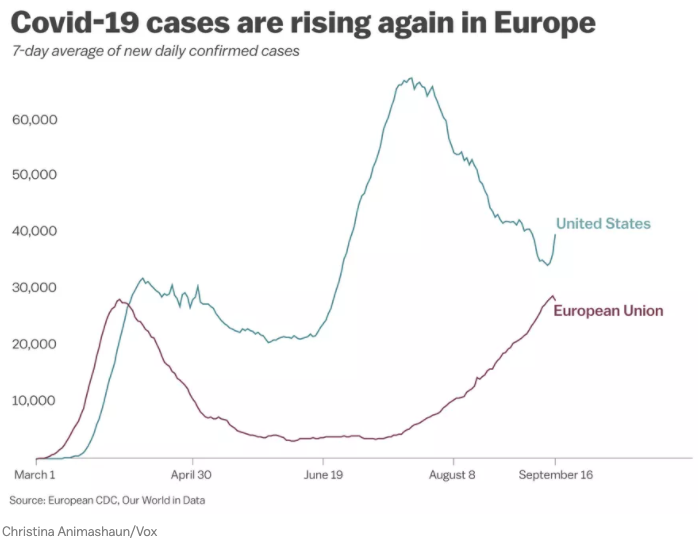
In looking at Europe, I’ll start with a place dear to my heart, The Netherlands:
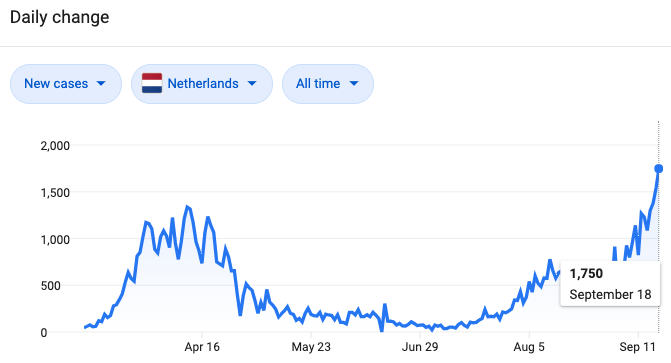
Based on the statistics, all the re-opening has clearly backfired. Right?
With all these new cases, we would expect to see rising deaths. If we consider August 1st as a start date for rising cases, we might expect deaths to follow by two to four weeks: that’s by September 1, at the latest. However, here’s what the data shows:
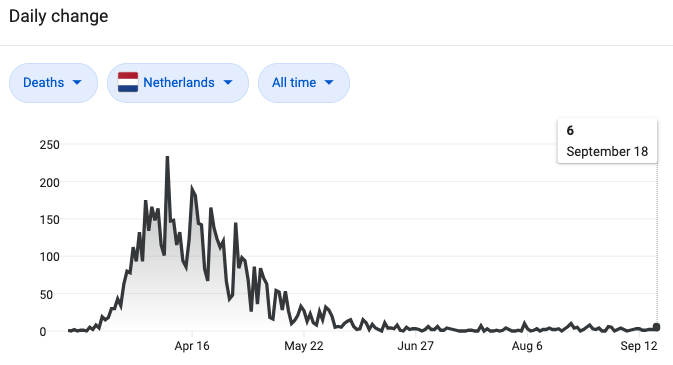
There have been few new Covid-19 related deaths in the Netherlands since early June and the number of new deaths is not rising with the number of new infection cases. This is very, very good news.
But why are so few deaths happening when the number of cases is clearly going up?
Here are a few reasons that probably address this lack of new Covid-related deaths:
- Information dissemination worked – elderly folks in the Netherlands heard the warnings and are being more careful, while young people are staying away from them.
- The number of cases back in March and April was drastically different than what was reported. For one, there was a dearth of testing kits, meaning that only those who really needed tests got them. Now, testing is widespread. That peak in April could have been three times higher back in April, but we have no way of knowing. This is a case of more testing leading to more positive results.
- The virus has become less deadly and doctors are treating it more effectively. There are therapies that significantly reduce the probability of dying from Covid-19 and doctors are using them, whereas, in April, this was not the case.
- Coronavirus May Have Mutated To Become More Contagious. Read more here: https://www.forbes.com/sites/joewalsh/2020/09/23/coronavirus-may-have-mutated-to-become-more-contagious-study-finds/
Next, let’s look at Spain:
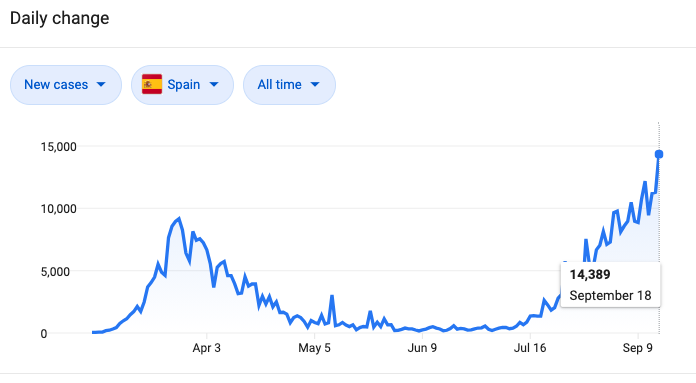
Again, there is a huge surge in new cases compared to two months ago. This surge, however, cannot be explained by more/less testing alone, because of the very low number of registered cases in early July when there was certainly testing happening. I believe this indicates that a second wave of Covid-19 is occurring.
Moreover, unlike the Netherlands, there has been an increase in new Covid-19 related deaths in Spain:
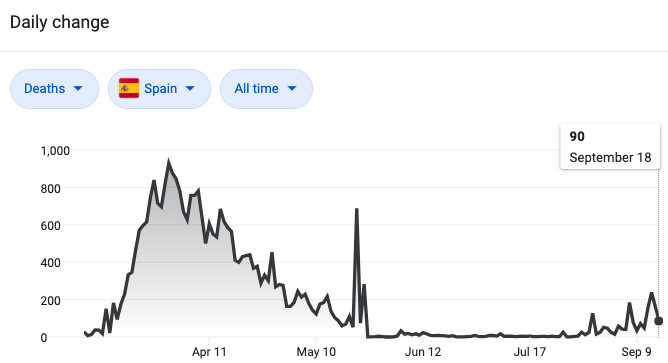
If we call July 10th the starting point of the increase of new cases, and August 15th the increase in deaths, there was roughly a four-week lag between the uptick in new cases and more deaths.
France is seeing something similar. Deaths are just starting to tick up:
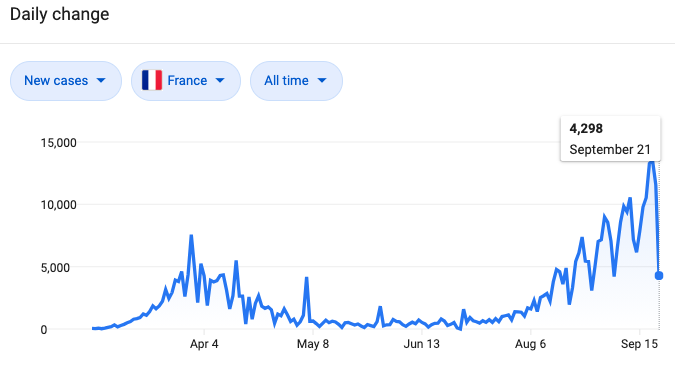
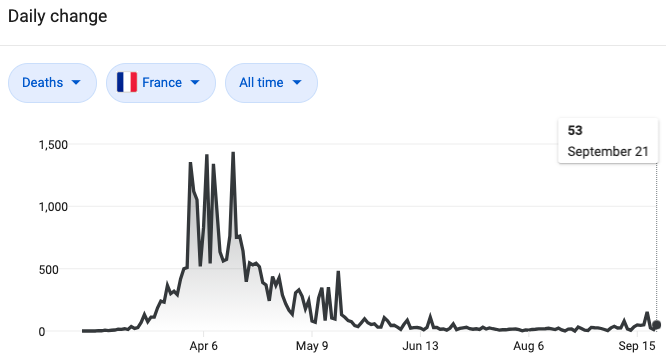
In other words, deaths are happening, but at a relatively low rate compared to all the positive cases found during testing.
What does this mean for the rest of the world?
Testing and new case counts are important indicators of where we stand in terms of the magnitude of the virus in a region, but it might not translate into deaths, as the Netherlands has shown us. Either that or the Netherlands is counting Covid-related deaths differently than other countries like France and Spain.
All the social gatherings across Europe have led to a lot of new Covid-19 cases.
Exactly what the consequences are has yet to be seen, but initially, it seems like Europe may handle this second wave of cases with far fewer fatalities. Here’s hoping that’s the case.
Read more on the surge of European Covid cases in this excellent VOX article: https://www.vox.com/21435868/coronavirus-france-italy-spain-uk-europe
To pull up the same plots I’m using here, just Google “worldwide covid deaths”
I hope you have a wonderful week. Stay healthy!
Of Interest
PyCaret 2.1 is here: What’s new?
PyCaret is an open-source, low-code machine learning library in Python that automates the machine learning workflow. It is an end-to-end machine learning and model management tool that speeds up the machine learning experiment cycle and makes you 10x more productive. Read about what’s new in PyCaret 2.1.
The Algorithm in the Armchair
Massive research efforts are now trying to harness the power of big data and machine learning for a more precise approach to mental health. By creating databases of patients’ brain activity, an algorithm might be able to figure out what clinicians can’t on their own: What makes this mentally ill person’s brain different from a healthy person’s? What treatment will their brain best respond to? The hope is that one day, just as a visit with a doctor is often followed with blood tests or scans, a mental health visit would be followed with some sort of brain imaging. Then an algorithm, trained on thousands of other people’s brains, could determine what disorder a person has, and what medication should be tried first.
How Google Maps Uses DeepMind’s A.I. Tools to Predict Your Arrival Time
Google Maps is one of the company’s most widely-used products, and its ability to predict upcoming traffic jams makes it indispensable for many drivers. Each day, says Google, more than 1 billion kilometers of road are driven with the app’s help. But, as the search giant explains in a blog post today, its features have got more accurate thanks to machine learning tools from DeepMind, the London-based AI lab owned by Google’s parent company Alphabet.
